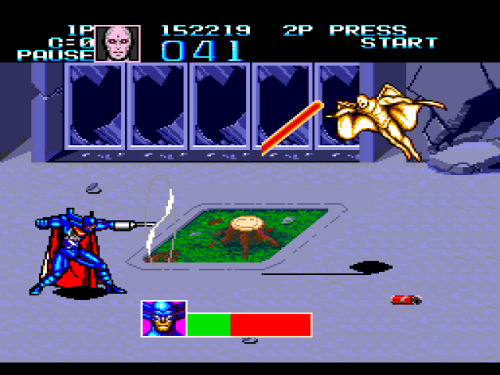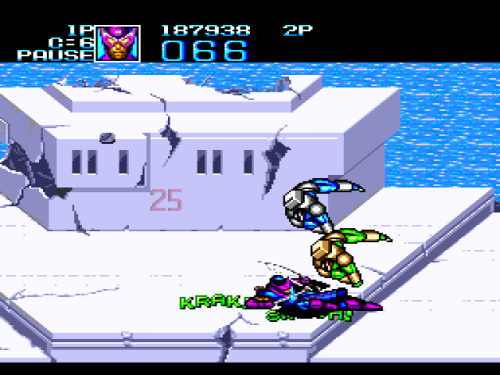I never played any of the home console versions of this, but I did play it in the arcade quite a few times. I did like the really bad Engrish and when you died your guy would say, "I...can't...moooooove!" It was entertaining, but there were certainly much better beat 'em ups out there.
Captain America and the Avengers Review Rewind
|
|
See PixlBit's Review Policies

On 10/01/2015 at 12:00 AM by Jamie Alston Some assembly required |

For anyone that enjoys a fairly decent brawler featuring one of the most enduring superhero teams.
As a small fledgling in the first grade, I liked comic books superheroes, but I wasn’t nearly as familiar with them as I am now. Sure, I knew about guys like Superman, Batman, and Spider-Man. But for the most part, I had only a narrow understanding of the world of comic books and the heroes within them.
One fateful day in 1991, I walked into an arcade at the local mall and I saw a bright new Captain America and The Avengers cabinet. Immediately, my interest was piqued. So I quickly pulled out two quarters and so began my formal education of Marvel superheroes. The game was later ported to a number of home consoles, including the Sega Genesis. Now Marvel enthusiasts everywhere could enjoy having The Avengers assemble on their television screen.
As the story goes, Red Skull used a mind control device to gather his group of super-villains to do his bidding. Such bidding includes robbing banks, terrorizing townsfolk, building underwater bases, and mounting a giant laser on the moon pointed at Earth. You know…typical super-villain stuff. Thankfully, the world can count on Captain America, Iron Man, Vision, and Hawkeye...and a few other Avengers that only make cameo appearances for some reason.

Your heroes have their basic set of punches, aerial attacks, and throws. Most important though, are each character’s special powers. Unsurprisingly, Captain America is the star of the show. Sure, Iron Man has his repulsor rays, Vision can fire his solar beam, and Hawkeye has those explosive arrows. But none those super abilities can compete with Captain America’s shield throw. This is particularly evident in the shoot ’em up portions of the game.
It was there that I discovered that even Iron Man struggles to bring down enemy gunships, thanks to his slow-firing repulsor rays. Yet, all Cap has to do is throw his shield several times and that flying monstrosity is down for the count. Although I felt compelled to use the other main characters for the sake of variety, Captain America is often a forced choice since he’s the all-around better hero of the 4 playable characters.
On a more positive note, props are due to Data East for their treatment of the cast of characters- particularly the villains in the game. Many that appear over the course of the game usually didn’t get much attention in other Marvel games of the time. I loved getting do battle with Klaw, the Living Laser, and Crossbones just to name a few. Of course, you’ll also have some of the better known villains like Ultron and Juggernaut.

Several other Avengers make cameo appearances to lend a hand to the main heroes at times. Now and then Quicksilver will run by (at an ironically slow pace) and drop a health item that replenishes energy. If you’re not playing as Vision or Iron Man, Wonder Man will appear and give you a small craft to use during flying sections.
During these segments, collecting the “W” icon brings forth The Wasp and she’ll assist the heroes with taking down enemies and ships. It would have been nice if the game had some kind method for unlocking those characters so you actually play as them.
The controls are mostly fine, but feel a bit clunky at times. Vision, Hawkeye, and Captain America tend to look a little stiff when walking (or flying for that matter). When Iron Man moves around, he looks like he’s going in cardiac arrest. To use their special moves, the function was mapped across two buttons. I know it mimics the arcade version’s two-button setup, but the Sega Genesis has three. I would have at least liked the option of mapping the “special” function to a third button, since the only other moves are “jump” and “punch”. Instead, the third button just serves as an extra attack (punch) function, and I just find it to be a little redundant.
This often results in crucial moments when you want to blast an enemy, but instead end up jumping or doing a simple punch. I usually ended up taking additional damage while trying to compensate for that one little misstep. Overall, the controls are okay; it just comes up a little short in terms of fluidity. Be prepared to take a beating from the bad guys too. Our heroes are easily surrounded and get knocked around a lot…sometimes more than I’d like to see in a game like this.

This visual presentation is decent, and pretty much on par with the arcade version. The comic book feel of the game is amplified by the “BOOM”, “KRACK”, “KABOOM”, and other such words appearing when you’re engaged in a fight. However, there are times when the Genesis’ limitations eventually show up.
This is mostly apparent in scenes where your heroes are switching from on-foot to flight sections and vice versa. There’s an odd pause before their animation abruptly changes. It ends up looking very blocky as a result. At certain parts in some levels, the screen will briefly scroll backward, then forward again before proceeding with the rest of the level. It’s not a huge deal, since it only happens once or twice, but it can be annoying for some.
Also, some of the character sprites for the boss villains were a little difficult to recognize. For instance, it took me a few play-throughs before I realized that Juggernaut was in the game. That’s because at first glance, he looks more like a one-eyed fat cyborg. I had to look at the avatar on his health bar before finally figuring out who he was. That having been said, the game mostly holds up well graphically, with just a few glaring faults manifesting themselves now and then.
The audio quality is a mixed bag. The music is pretty nice, feature the same tunes from the arcade version, albeit with some minor differences in the musical composition. I enjoyed its stereotypical ‘90s superhero motif. It’s really upbeat and somehow fits perfectly into a Marvel game.

The voice work is also present in the home port, and it already wasn’t that great in the arcade version. The Genesis sound hardware makes most of the voice work sound grainy and tinny. If not for the accompanying dialogue box, I’d be hard-pressed to know what was being said in certain scenes. Not that there’s much to miss with award-winning lines like: (hero) “There’s no escape”. (Whirlwind) “YOU will be the one escaping!” One of my favorite lines is: (Hero) “Where’s the laser?” (Ultron) “Ask the police”. Classic.
Additionally, it sounds like every character was voiced by the same guy. While the vocals do evoke a comic book feel, it ends up putting the game on the campy side of story-telling. Not that arcade beat ‘em ups were supposed to have an academy award-worthy story anyway. As bad as I might make these things out to be, it actually adds to fun of the game, even if it is a little campy at times.
All things considered, the Genesis version of Captain and The Avengers is a faithful port of the arcade original and the best out of the other console ports. If you like games like Capcom’s Captain Commando or Final Fight, the you’ll likely find something to like about this game. As an avid fan myself, I definitely recommend this to anyone with a remote interest in the Marvel universe. It’s a fairly popular entry in comic book gaming history and there’s enough here to like. And even if you favor the DC heroes over Marvel, that’s okay. America still needs your help.
For years when I'd play this game, one question had always plagued me- why does Vision look so...vanilla? The Vision I was familiar with had a much more colorful look with his traditional red, green, and yellow appearance. For years, I thought Data East was just being lazy and decided to leave his color palette blank. But as I later learned, they were right on the money.
It started with a story arc in 1989 called “Vision Quest” (West Coast Avengers #42-45). Here, a group of shadowy U.S. government agents capture Vision and dismantle him. A short time later, the Avengers recover his parts and Dr. Hank Pym (the original Ant-Man) successfully rebuilds him. Unfortunately, Vision was now devoid of all emotion until much later down the line. Worse yet, his synthetic skin was a chalk-white complexion due to the damage he incurred while being dismantled.
The Captain America and the Avengers arcade game was released during the aftermath of these events, hence the colorless Vision. So, if any readers out there were like me and felt a bit confused about Vision’s appearance- the mystery has been solved. You’re welcome.










Side By Side - Vision Quest